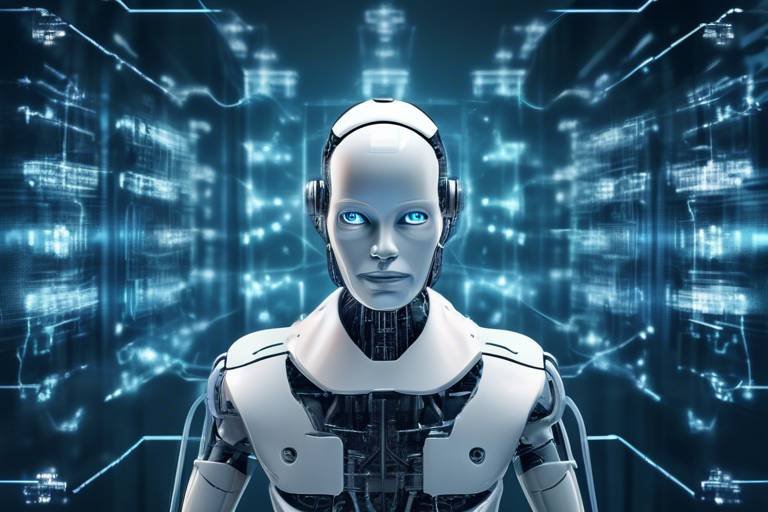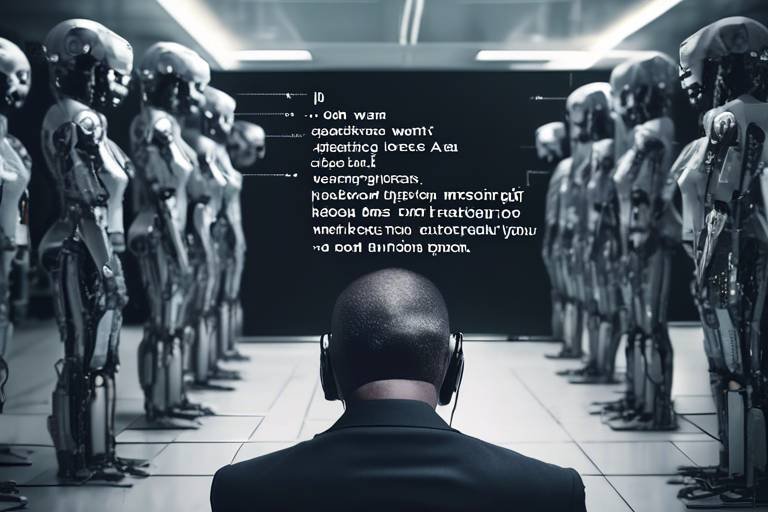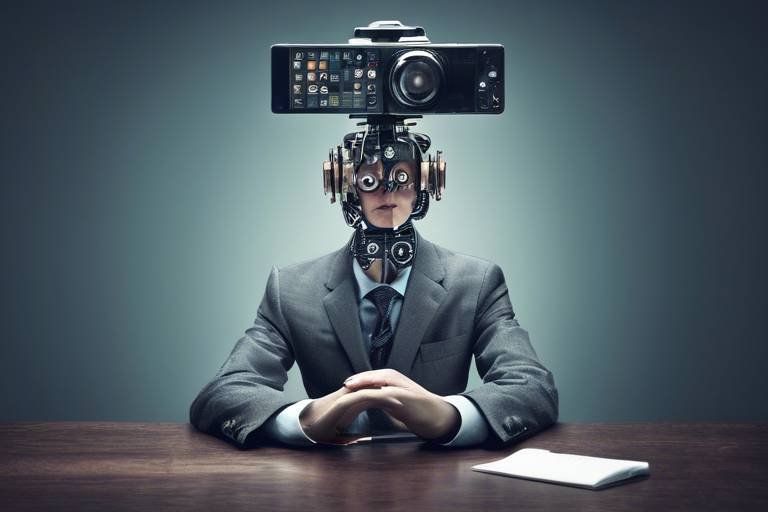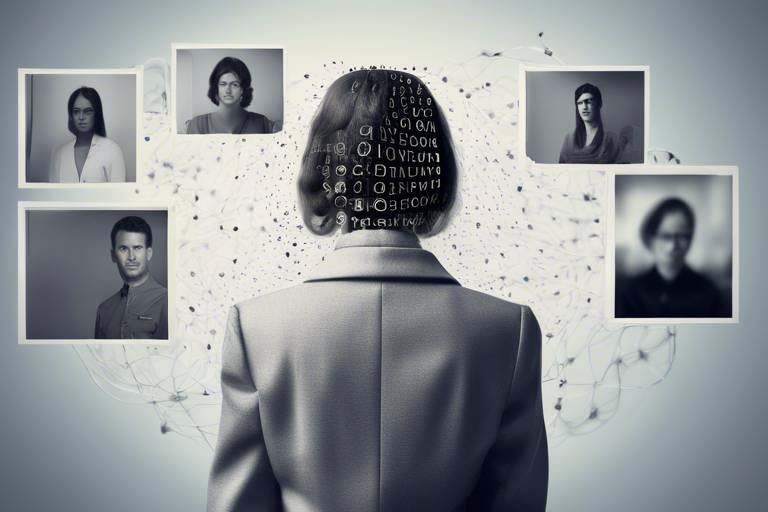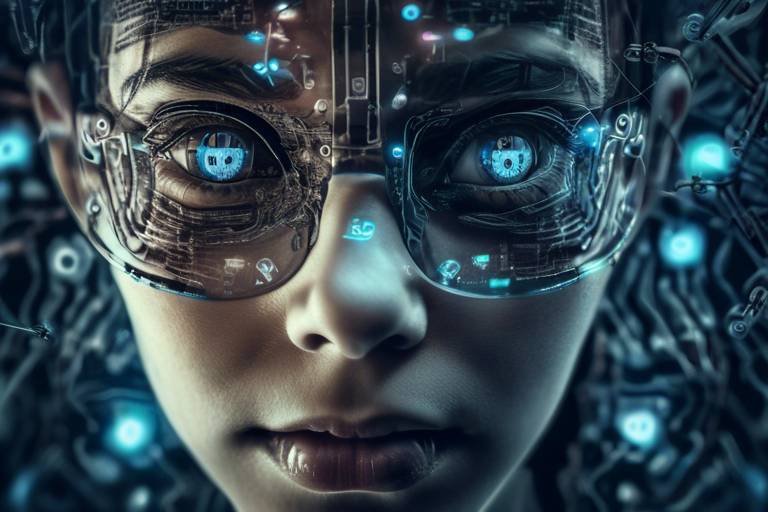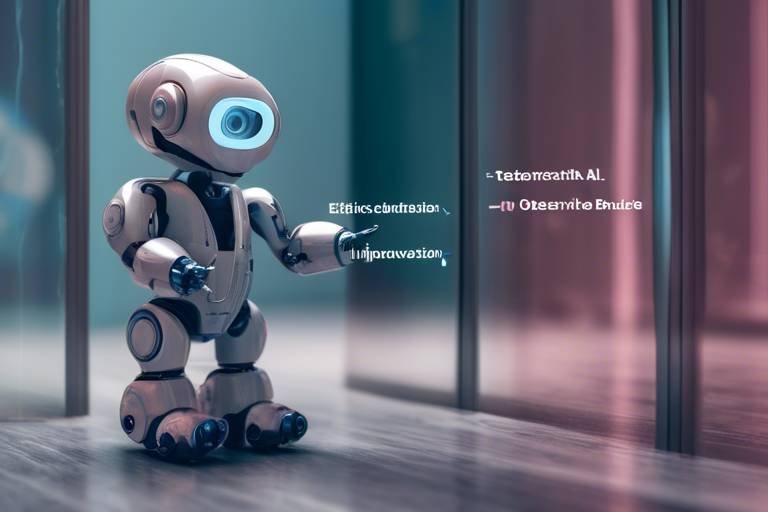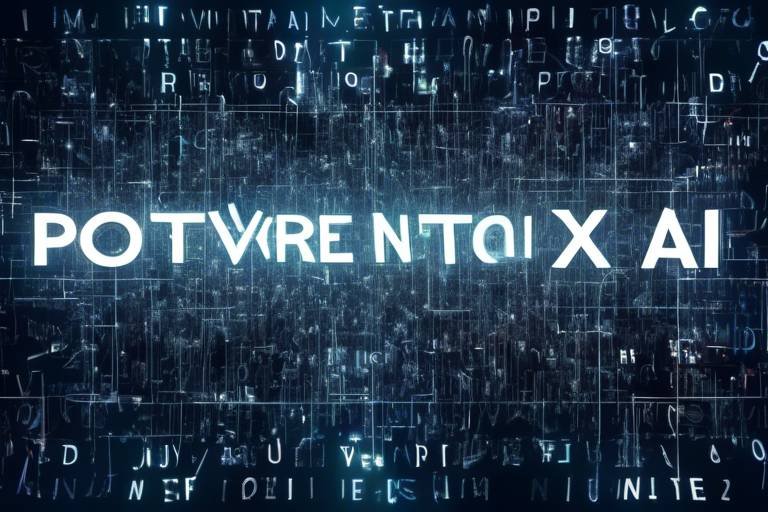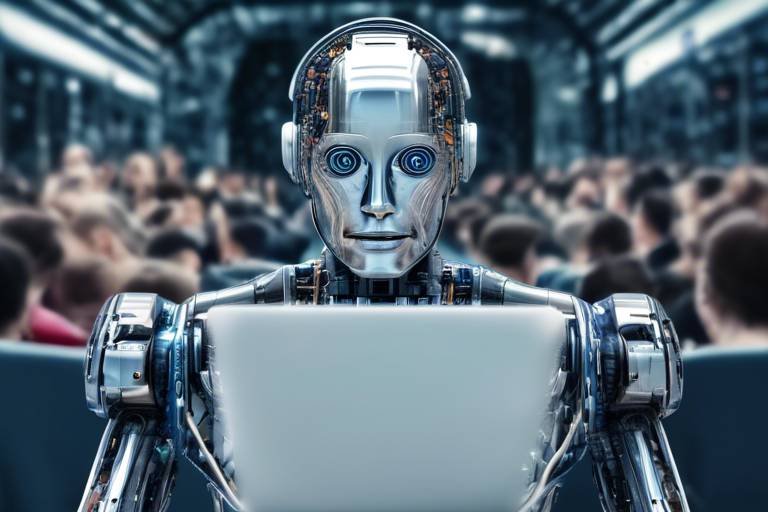The Future of AI: Navigating Ethical Challenges
As we stand on the brink of an AI-driven revolution, it’s crucial to pause and reflect on the ethical implications that come with this technological marvel. The rapid development of artificial intelligence is akin to a double-edged sword; while it holds great promise for enhancing our lives, it also raises significant ethical questions that we must address. How do we ensure that AI serves humanity positively? What frameworks do we need to establish to navigate the murky waters of ethical dilemmas? In this article, we will explore the multifaceted landscape of AI ethics, addressing the challenges we face and the potential solutions that can guide us toward a responsible future.
At its core, AI ethics is about ensuring that artificial intelligence technologies are developed and deployed responsibly. This involves a comprehensive understanding of the moral principles that should guide the creation and implementation of AI systems. Just like a ship needs a compass to navigate through stormy seas, society requires a robust ethical framework to steer AI developments in a direction that benefits all. The significance of AI ethics cannot be overstated; as we integrate AI into various facets of life—be it healthcare, finance, or education—ensuring that these technologies are aligned with our shared values becomes paramount.
One of the most pressing issues in the realm of AI ethics is data privacy. In an era where data is often referred to as the new oil, understanding how data is collected, stored, and utilized is critical. Imagine walking through a bustling market, where every vendor knows your preferences and habits. That's essentially what AI does with data—it analyzes and predicts behaviors based on the information it gathers. However, this raises significant implications for individual rights. Are we comfortable with the idea that our personal data is being used to train algorithms that could potentially make decisions about our lives? The need for stringent data protection measures has never been more urgent.
Another ethical challenge we face is the presence of bias in AI algorithms. Bias can seep into AI systems from various sources, including the data used to train them and the decisions made by developers. For instance, if an AI system is trained on data that reflects historical inequalities, it may perpetuate those biases, leading to unfair outcomes. This is especially concerning in sectors like hiring, law enforcement, and lending, where biased algorithms can have serious consequences on people's lives. Understanding the origins of bias and actively working to mitigate it is essential for creating fair and equitable AI systems.
As AI systems become more autonomous, the question of accountability looms large. When an AI makes a decision that results in harm or loss, who is responsible? Is it the developer, the user, or the AI itself? This ambiguity can create a legal and moral quagmire. Just as we hold human decision-makers accountable for their actions, we must establish clear guidelines for AI accountability. This involves developing legal frameworks that recognize the unique challenges posed by autonomous systems while ensuring that those impacted by AI decisions have avenues for redress.
In light of these challenges, the role of regulation in AI development becomes increasingly vital. Regulatory frameworks can provide the necessary oversight to ensure that AI technologies are developed ethically and responsibly. Current efforts around the globe aim to establish guidelines that promote transparency, fairness, and accountability in AI systems. However, creating effective regulations requires a collaborative approach involving policymakers, technologists, and ethicists. By working together, we can forge policies that not only protect individuals but also foster innovation.
With the rise of AI comes the concern of job displacement. As machines become capable of performing tasks traditionally done by humans, many fear for their livelihoods. However, rather than viewing AI solely as a threat, we should consider it an opportunity for workforce adaptation and reskilling. Just as the industrial revolution transformed labor markets, AI can lead to new job creation in sectors we can't even imagine yet. Embracing this change involves investing in education and training programs that prepare the workforce for the future.
Transparency is another critical aspect of ethical AI. Users must understand how AI systems operate and make decisions. Imagine driving a car where you have no idea how it navigates through traffic—it's a recipe for disaster! By promoting transparency in AI operations, we can build trust between users and technology. This means clear communication about how algorithms function, the data they use, and the rationale behind their decisions. Transparency not only empowers users but also encourages developers to create more ethical systems.
The way the public perceives AI significantly influences its development and acceptance. Misinformation and fear can hinder progress, while education and awareness can foster a more informed dialogue. Just like a well-told story can change hearts and minds, effective communication about AI's benefits and risks can shape public opinion positively. Engaging communities in discussions about AI ethics is essential for building a future where technology and society coexist harmoniously.
As we look ahead, it is crucial to propose ethical frameworks that guide developers and policymakers in creating responsible AI systems. These frameworks should prioritize human rights, promote fairness, and ensure accountability. By establishing a set of guiding principles, we can navigate the complexities of AI ethics and work towards a future where technology enhances our lives without compromising our values.
- What is AI ethics? AI ethics refers to the moral principles that guide the development and deployment of artificial intelligence technologies.
- Why is data privacy important in AI? Data privacy is crucial to protect individual rights and ensure that personal information is not misused by AI systems.
- How can bias in AI be mitigated? Bias can be mitigated through careful data selection, algorithm auditing, and ongoing monitoring of AI systems.
- Who is accountable for AI decisions? Accountability in AI is complex and involves developers, users, and potentially the AI systems themselves.
- What role does regulation play in AI? Regulation helps ensure that AI technologies are developed ethically and responsibly, protecting individuals and promoting innovation.

Understanding AI Ethics
As we stand on the brink of a technological revolution, it’s crucial to grasp the concept of AI ethics. This field encompasses the moral implications and responsibilities that come with the development and deployment of artificial intelligence systems. Think of it as the compass guiding us through uncharted waters—helping us navigate the complexities and potential pitfalls of AI technologies. Why does this matter? Because, without a solid ethical foundation, we risk creating systems that could harm individuals and society at large.
At its core, AI ethics seeks to address the fundamental question: How can we ensure that AI serves humanity positively? This involves examining the principles that should govern AI development, such as fairness, accountability, transparency, and respect for human rights. These principles act as the bedrock upon which responsible AI can be built. For instance, if AI systems are designed without considering fairness, we might end up with biased algorithms that perpetuate discrimination. This is why engaging in ethical discussions is not just a nice-to-have; it’s a necessity.
Moreover, the significance of AI ethics extends beyond technical specifications. It touches upon societal values and individual rights, making it imperative for developers, policymakers, and users to collaborate. When we talk about ethics in AI, we’re also talking about the impact on society. For example, consider the implications of AI in healthcare. While AI can enhance diagnostic accuracy, it also raises questions about patient privacy and consent. Are we prepared to handle the ethical dilemmas that arise when AI systems make decisions affecting human lives?
To better understand the landscape of AI ethics, let’s break it down into several key components:
- Fairness: Ensuring that AI systems do not discriminate against individuals or groups based on race, gender, or socioeconomic status.
- Accountability: Establishing who is responsible for the outcomes of AI decisions, particularly in scenarios where errors lead to harm.
- Transparency: Making AI operations understandable to users and stakeholders, fostering trust and confidence in these technologies.
- Privacy: Protecting individual data rights and ensuring that personal information is handled with care.
In conclusion, as we delve deeper into the world of AI, understanding its ethical implications becomes more critical than ever. The decisions we make today will shape the future of technology and its role in our lives. By prioritizing AI ethics, we can harness the power of artificial intelligence responsibly and equitably, paving the way for innovations that truly benefit society.

Data Privacy Concerns
In today's digital age, data privacy has emerged as a paramount concern, especially with the rise of artificial intelligence (AI). As we increasingly rely on AI systems to enhance our daily lives, the question arises: how much of our personal information are we willing to share? With AI's capability to analyze vast amounts of data, the potential for misuse is significant. It's essential to understand not just how our data is collected, but also how it is stored, processed, and ultimately utilized. Every time we engage with an AI-driven application, we leave behind a digital footprint that can reveal our preferences, behaviors, and even our identities.
The implications of inadequate data privacy measures can be severe. Imagine a world where sensitive personal information is easily accessible to unauthorized entities or used for malicious purposes. For instance, data breaches can lead to identity theft, financial loss, and a breach of trust between users and service providers. Additionally, the way AI systems are designed to gather data often lacks transparency, leaving users in the dark about what information is being collected and for what purpose. This lack of clarity can create a sense of unease and skepticism among users.
Moreover, the collection of data often occurs without explicit consent from users. Companies may use vague terms of service agreements that obscure the true nature of data usage. This raises ethical questions about consent and the rights of individuals to control their own information. As we navigate this AI-driven landscape, it's crucial to establish clear guidelines regarding data collection practices. Here are some key aspects to consider:
- Informed Consent: Users should have a clear understanding of what data is being collected and how it will be used.
- Data Minimization: Only the necessary data should be collected, reducing the risk of misuse.
- Right to Access: Individuals should have the right to access their data and request its deletion if desired.
As we delve deeper into the ethical implications of AI, it's evident that addressing data privacy concerns is not just a technical challenge but a moral imperative. The stakes are high, and the consequences of neglecting these issues could lead to a society where personal privacy is a relic of the past. Therefore, it is essential for developers, policymakers, and users to collaborate in crafting a future where data privacy is respected and upheld.
In conclusion, while AI has the potential to revolutionize our lives, we must tread carefully. By prioritizing data privacy, we can ensure that technological advancements do not come at the expense of our fundamental rights. As we move forward, the conversation around data privacy must remain at the forefront, guiding the development of AI in a way that is ethical, responsible, and beneficial for all.
- What is data privacy in the context of AI?
Data privacy refers to the proper handling, processing, and storage of personal information collected by AI systems. - How can I protect my data when using AI applications?
Always read privacy policies, opt for applications that prioritize data protection, and limit the information you share. - What are the consequences of poor data privacy?
Poor data privacy can lead to identity theft, financial loss, and a general distrust in technology.

Bias in AI Algorithms
When we talk about artificial intelligence, it’s hard to ignore the elephant in the room: bias. Yes, bias in AI algorithms is a critical issue that can have profound implications on our society. Imagine a world where a machine makes decisions for you—be it in hiring, lending, or even law enforcement. Sounds convenient, right? But what if that machine is making decisions based on biased data? That’s where the real trouble begins.
AI systems learn from vast amounts of data, and if that data is skewed or unrepresentative, the algorithms will inevitably reflect those biases. For instance, if an AI is trained on historical hiring data that favors one demographic over another, it may perpetuate those same inequalities. This isn’t just a theoretical concern; it’s happening right now. Studies have shown that AI-driven hiring tools can favor candidates of certain backgrounds, leading to a lack of diversity in the workplace.
But how does bias creep into AI algorithms in the first place? Here are some common sources:
- Data Collection: Bias can originate from the way data is collected. If the data is not inclusive or represents only a fraction of the population, the AI will learn from a distorted view of reality.
- Historical Bias: AI systems often learn from historical data that may contain societal biases, like discrimination based on race or gender.
- Algorithm Design: Sometimes, the very algorithms themselves are designed in a way that favors certain outcomes over others, leading to biased results.
The consequences of biased AI are far-reaching. In the criminal justice system, for example, algorithms used for predicting recidivism rates have been shown to disproportionately target minority groups. This can lead to unfair sentencing and a cycle of inequality that is hard to break. Similarly, in healthcare, biased algorithms can affect the quality of care that individuals receive, often leaving marginalized communities underserved.
So, what can we do about it? Addressing bias in AI algorithms requires a multi-faceted approach:
- Inclusive Datasets: Developers should prioritize the use of diverse and representative datasets to train their algorithms.
- Regular Audits: Conducting regular audits of AI systems can help identify and mitigate biases before they cause harm.
- Transparency: Companies should be transparent about how their algorithms work and what data they use, allowing for greater scrutiny and accountability.
In conclusion, the bias in AI algorithms is a pressing issue that we cannot afford to ignore. As we continue to integrate AI into various aspects of our lives, it’s crucial to ensure that these systems are fair, equitable, and just. The responsibility lies with developers, policymakers, and society as a whole to create a future where AI serves everyone, not just a select few.
Q: What is bias in AI algorithms?
A: Bias in AI algorithms refers to the tendency of AI systems to produce results that are systematically prejudiced due to flawed data or design.
Q: How can we identify bias in AI systems?
A: Bias can be identified through regular audits, testing with diverse datasets, and monitoring outcomes for fairness across different demographics.
Q: What are the consequences of biased AI?
A: Biased AI can lead to unfair treatment in various sectors, including hiring, law enforcement, and healthcare, perpetuating existing inequalities.
Q: How can we mitigate bias in AI?
A: Mitigating bias involves using inclusive datasets, conducting audits, and ensuring transparency in algorithm design and data usage.

Accountability in AI Decisions
As we delve deeper into the realm of artificial intelligence, one of the most pressing questions that arises is, who is accountable for the decisions made by AI systems? This issue is not just a technical concern; it's a moral and legal dilemma that impacts everyone from developers to end-users. Imagine a self-driving car that makes a split-second decision leading to an accident. Who takes the blame—the car manufacturer, the software developer, or the owner? This ambiguity creates a complex web of accountability that we must unravel as AI technology continues to evolve.
At the heart of this issue lies the challenge of autonomy. AI systems are designed to operate independently, making decisions based on algorithms and data inputs. However, this independence raises questions about the extent to which humans can be held responsible for those decisions. For instance, if an AI system makes a biased hiring decision, is it the fault of the algorithm, the data it was trained on, or the company that deployed it? The layers of responsibility become increasingly convoluted, making it essential for us to establish clear lines of accountability.
Moreover, the legal frameworks that govern AI are still in their infancy. Current laws often struggle to keep pace with the rapid advancements in AI technology. This gap can lead to situations where victims of AI-driven decisions have limited recourse for justice. For example, if an AI system denies someone a loan based on biased data, the affected individual may find it challenging to pinpoint responsibility or seek compensation. This lack of accountability not only undermines trust in AI systems but also raises ethical concerns about fairness and justice.
To address these accountability challenges, several approaches can be considered:
- Establishing Clear Guidelines: Policymakers need to create comprehensive guidelines that define accountability in AI systems. This includes determining who is responsible for different aspects of AI decision-making.
- Implementing Auditing Mechanisms: Regular audits of AI systems can help identify biases and errors, holding developers accountable for the performance of their algorithms.
- Encouraging Transparency: Developers should be required to disclose how their AI systems make decisions, allowing for greater scrutiny and accountability.
In addition, fostering a culture of ethical AI development is crucial. Companies should prioritize ethical considerations in their AI projects, ensuring that accountability measures are integrated from the outset. This proactive approach not only protects users but also enhances the reputation of organizations that prioritize responsible AI practices.
As we look to the future, the question of accountability in AI decisions will remain at the forefront of discussions around AI ethics. It is imperative that we navigate this landscape thoughtfully, ensuring that as AI systems become more integrated into our daily lives, they do so with a framework that upholds accountability, fairness, and justice for all.
- What is accountability in AI? Accountability in AI refers to the responsibility for decisions made by AI systems, including who can be held liable for those decisions.
- Why is accountability important in AI? Accountability is crucial to ensure trust and fairness in AI systems, as it helps protect users' rights and provides a means for recourse in case of harm.
- How can we improve accountability in AI? Improving accountability can be achieved through clear guidelines, regular audits, transparency in decision-making, and fostering an ethical development culture.

The Role of Regulation
As we stand on the brink of an AI revolution, the importance of regulation cannot be overstated. The rapid advancement of artificial intelligence technologies brings with it a myriad of ethical dilemmas that require careful consideration and oversight. Without a robust regulatory framework, we risk creating a landscape where innovation outpaces our ability to manage its consequences. Think of regulation as the safety net that ensures we can explore the thrilling heights of AI without falling into the abyss of ethical misconduct.
Regulation serves several critical purposes in the realm of AI. Firstly, it helps to establish standards that guide the development and deployment of AI systems. These standards can address issues such as data privacy, algorithmic transparency, and bias mitigation. By setting clear expectations, regulatory bodies can foster an environment where developers prioritize ethical considerations alongside technical advancements. In essence, regulations act as a compass, steering the AI industry towards responsible practices.
Moreover, regulation plays a vital role in protecting consumers and maintaining public trust. As AI systems become more integrated into our daily lives, from healthcare to finance, the need for accountability grows. If a self-driving car makes a mistake, who is to blame? Is it the manufacturer, the software developer, or the data provider? These questions highlight the necessity for legal frameworks that clarify accountability in AI-driven decisions. Without such frameworks, consumers may hesitate to embrace AI technologies, fearing potential harm or misuse.
To illustrate the complexities of regulation, consider the following table that outlines key areas where regulation is essential:
| Regulatory Focus | Description |
|---|---|
| Data Privacy | Ensuring that personal data is collected, stored, and used in compliance with privacy laws. |
| Algorithmic Bias | Establishing guidelines to minimize bias in AI algorithms and promote fairness. |
| Accountability | Defining who is responsible for decisions made by AI systems to protect consumers. |
| Transparency | Mandating clear communication regarding how AI systems operate and make decisions. |
While the need for regulation is clear, the path forward is fraught with challenges. Striking a balance between fostering innovation and ensuring safety can be tricky. Over-regulation might stifle creativity and slow down progress, while under-regulation could lead to catastrophic failures. Therefore, it’s crucial to engage various stakeholders—including developers, policymakers, ethicists, and the public—in discussions about the best approaches to regulation. This collaborative effort can help create a framework that is both flexible and robust.
In conclusion, the role of regulation in the AI landscape is multifaceted and essential. It not only helps to protect individuals and society but also guides developers toward creating responsible and ethical AI systems. As we continue to navigate this uncharted territory, the development of thoughtful regulatory frameworks will be crucial in ensuring that AI serves as a force for good, rather than a source of concern.
- What are the main goals of AI regulation? The primary goals include protecting consumer rights, ensuring data privacy, reducing bias, and promoting transparency in AI systems.
- Who is responsible for regulating AI? Regulation typically involves collaboration among government agencies, industry leaders, ethicists, and the public.
- How can regulation impact AI innovation? While regulation can provide necessary guidelines, overly stringent rules may hinder creativity and slow down technological advancements.
- What are some examples of existing AI regulations? Examples include the General Data Protection Regulation (GDPR) in Europe, which addresses data privacy, and various initiatives aimed at algorithmic accountability.

AI and Job Displacement
As we stand on the brink of an AI-driven revolution, one of the most pressing concerns is the impact of artificial intelligence on the job market. It’s like watching a tidal wave approach from the horizon—exciting yet terrifying. The rapid advancement of AI technologies promises to enhance productivity and efficiency, but it also raises questions about the future of work. Will machines take over our jobs? Or can we adapt and thrive alongside them? The truth lies somewhere in between.
AI systems are increasingly capable of performing tasks that were once the exclusive domain of humans. From automating routine office tasks to driving vehicles, AI is reshaping the workforce landscape. For instance, industries such as manufacturing, customer service, and even healthcare are experiencing significant transformations. In manufacturing, robots are not just assisting; they are taking over assembly lines, leading to increased efficiency but also job losses. According to a recent report, it’s estimated that up to 85 million jobs worldwide could be displaced by 2025 due to AI and automation.
However, it’s crucial to remember that while AI might displace certain jobs, it also creates new opportunities. Just as the Industrial Revolution led to the demise of some jobs but birthed entirely new industries, AI is expected to do the same. For example, roles in AI development, data analysis, and cybersecurity are on the rise. This shift calls for a workforce that is adaptable and willing to reskill. It’s not just about losing jobs; it’s about evolving with technology. Companies and educational institutions must work together to provide training programs that equip workers with the skills needed for the jobs of the future.
Moreover, the fear of job displacement often overshadows the potential benefits of AI in enhancing job quality. Many tasks that are repetitive and mundane can be automated, allowing employees to focus on more meaningful and creative aspects of their work. Imagine a world where your job isn’t just about crunching numbers or answering calls, but instead involves strategic thinking and innovation. This shift could lead to greater job satisfaction and a more engaged workforce.
To better understand the impact of AI on various sectors, let’s take a look at a comparative table illustrating the potential job displacement and creation across different industries:
| Industry | Potential Job Displacement | Potential Job Creation |
|---|---|---|
| Manufacturing | 5 million | 2 million |
| Healthcare | 1 million | 3 million |
| Customer Service | 2 million | 1 million |
| IT & Cybersecurity | 500,000 | 4 million |
In conclusion, while the fear of job displacement due to AI is valid, it’s essential to adopt a balanced perspective. Embracing the changes brought by AI can lead to new opportunities and an improved quality of work life. By investing in education and reskilling programs, society can ensure that the workforce is prepared to meet the challenges of an AI-integrated future. The key lies in adaptability and a willingness to learn, much like a chameleon that changes its colors to thrive in its environment.
- Will AI take all jobs? No, while AI may displace certain jobs, it will also create new opportunities in emerging fields.
- What can I do to prepare for an AI-driven job market? Focus on developing skills that are complementary to AI, such as creativity, critical thinking, and emotional intelligence.
- How can companies support employees facing job displacement? Companies can offer reskilling programs and career transition support to help employees adapt to new roles.

Transparency in AI Systems
In the rapidly evolving landscape of artificial intelligence, transparency stands out as a critical pillar for building trust and fostering acceptance among users. Imagine trying to navigate a maze without knowing where the exits are; that’s how many people feel about AI systems today. When users interact with AI, they often lack insight into how decisions are made, which can lead to skepticism and fear. Transparency in AI is not just about making the algorithms visible; it’s about creating an environment where users can understand the rationale behind AI decisions, thus enhancing their confidence in these technologies.
One of the main reasons transparency is essential is that it contributes to accountability. If users know how an AI system operates, they can better identify when something goes wrong. For instance, if a self-driving car makes an unexpected decision, understanding the algorithm's logic can help determine whether it was a design flaw or an unforeseen circumstance. Without this clarity, the blame could easily shift between developers, manufacturers, and users, complicating accountability.
Moreover, transparency can help mitigate the risks of bias in AI systems. When the workings of an algorithm are opaque, it can perpetuate existing biases or create new ones without anyone realizing it. By making AI systems more transparent, developers can identify and rectify biases in their algorithms, ensuring that the technology serves all users fairly. For example, if an AI recruitment tool favors certain demographics over others, transparency allows for scrutiny and adjustments to be made, promoting a more equitable hiring process.
To achieve this level of transparency, several strategies can be employed:
- Open Algorithms: Encourage organizations to share their algorithms and datasets, allowing for external audits and scrutiny.
- User-Friendly Explanations: Develop tools that explain AI decisions in plain language, making it easier for non-experts to understand.
- Stakeholder Engagement: Involve users and affected communities in the design and deployment phases, ensuring their concerns are addressed.
As we move forward, the importance of transparency in AI systems cannot be overstated. It’s not just a technical requirement; it’s a societal necessity. By fostering an environment where users are informed about how AI systems work, we can build a future where technology enhances human capabilities rather than undermines them. The road to transparency is paved with challenges, but it is essential for ensuring that AI serves the greater good.
- What is transparency in AI? Transparency in AI refers to the clarity and openness about how AI systems operate, including the algorithms used and the data processed.
- Why is transparency important? Transparency is crucial for accountability, trust, and reducing bias in AI systems, helping users understand and scrutinize AI decisions.
- How can transparency be achieved? Transparency can be achieved through open algorithms, user-friendly explanations, and stakeholder engagement throughout the AI development process.

Public Perception of AI
When we think about artificial intelligence, the first thing that often comes to mind is a scene straight out of a sci-fi movie—robots taking over the world, or perhaps a friendly AI assistant helping us with our daily tasks. But the reality is much more nuanced and layered. Public perception of AI is a fascinating blend of excitement, skepticism, and fear. How do we navigate these complex feelings as we step into an AI-driven future?
One of the primary factors influencing public perception is media portrayal. Films, TV shows, and news articles often dramatize AI, leading to a mix of curiosity and concern. For instance, movies like "The Terminator" paint AI as a potential threat, while others, like "Her," showcase a more intimate relationship between humans and AI. This duality creates a sense of confusion about what AI truly represents. Are we looking at a tool for our advancement, or a harbinger of doom?
Another significant aspect is education and awareness. Many people lack a fundamental understanding of how AI works, which can lead to misconceptions. For example, a survey conducted by the Pew Research Center found that only 29% of Americans feel they have a good understanding of AI technology. This gap in knowledge can foster fear and mistrust. If people don’t understand how AI systems make decisions, it’s natural for them to be wary of their implications. Education initiatives that demystify AI can play a crucial role in shaping a more positive public perception.
Moreover, the impact of social media cannot be underestimated. Platforms like Twitter and Facebook serve as echo chambers where opinions can rapidly spread—both positive and negative. A single viral post can sway public sentiment, either amplifying fears or celebrating advancements. This phenomenon often leads to polarized views, making it challenging to reach a consensus on how AI should be integrated into society.
Interestingly, the perception of AI also varies significantly across different demographics. Younger generations tend to be more optimistic about AI's potential benefits, while older individuals often express more caution. According to a recent study, 60% of millennials believe AI will improve their lives, compared to only 30% of baby boomers. This generational gap highlights the need for tailored communication strategies that resonate with different age groups.
To further understand public perception, we can break down the general sentiments into three categories:
- Optimism: Many view AI as a transformative technology that can solve complex problems, enhance productivity, and improve quality of life.
- Skepticism: There are concerns about privacy, security, and the ethical implications of AI decisions, leading to a cautious approach.
- Fear: Some people fear job displacement and the potential for AI to be used in harmful ways, such as surveillance or warfare.
As we move forward, it’s essential to address these perceptions through open dialogue. Engaging the public in discussions about AI ethics, its applications, and its implications can help build trust. Moreover, transparency in AI development is key; when people understand how these systems operate and the safeguards in place, they’re more likely to embrace the technology. By fostering a culture of collaboration between developers, policymakers, and the public, we can create a future where AI is seen not just as a tool, but as a partner in progress.
In conclusion, the public perception of AI is a complex tapestry woven from various threads of emotion, belief, and understanding. As we continue to advance in this field, addressing these perceptions head-on will be crucial in ensuring that AI is developed and implemented responsibly and ethically.
- What is the biggest concern people have about AI? Many people are concerned about privacy and the potential for job displacement due to automation.
- How can education improve public perception of AI? By providing clear information about how AI works and its benefits, education can help dispel myths and reduce fear.
- What role does media play in shaping views on AI? Media can significantly influence public perception by either highlighting the benefits or emphasizing the risks associated with AI.

Future Ethical Frameworks
As we stand on the brink of an AI-driven future, the need for robust ethical frameworks has never been more critical. These frameworks will serve as a compass, guiding developers, policymakers, and society at large in navigating the complex landscape of artificial intelligence. Imagine setting sail on uncharted waters without a map; that's akin to advancing AI technologies without ethical guidelines. So, what should these frameworks encompass?
Firstly, a comprehensive ethical framework must prioritize human rights. This means ensuring that AI systems are designed and implemented in ways that respect individual freedoms and dignity. For instance, consider how facial recognition technology has sparked debates over privacy and surveillance. An ethical framework should mandate transparency in how such technologies are used and who has access to the data they collect.
Moreover, these frameworks should incorporate principles of fairness and accountability. Bias in AI algorithms can lead to unfair treatment of individuals based on race, gender, or socioeconomic status. A future ethical framework must include rigorous testing and validation processes to identify and mitigate biases in AI systems. This can be likened to a chef tasting their dish before serving it; just as a chef wants to ensure the meal is perfect, developers must ensure their AI is fair and just.
Another essential component is the promotion of transparency. Users and stakeholders should be able to understand how AI systems make decisions. This could involve creating clear documentation and user-friendly interfaces that explain the underlying algorithms. Imagine trying to solve a puzzle without knowing what the picture looks like; that’s how users feel when they encounter opaque AI systems. Transparency can build trust and foster a more informed public discourse about AI.
Furthermore, collaboration between various stakeholders is vital. This includes not just technologists and businesses, but also ethicists, sociologists, and the general public. By fostering an inclusive dialogue, we can create a more holistic approach to AI ethics. Think of it as a community garden; when diverse individuals come together, each contributing their unique perspectives, the result is a richer, more vibrant ecosystem.
To illustrate these concepts, let’s consider a potential framework that incorporates the following elements:
| Element | Description |
|---|---|
| Human Rights | Protecting individual freedoms and ensuring dignity in AI applications. |
| Fairness | Ensuring AI systems are free from bias and discrimination. |
| Transparency | Providing clear insights into how AI systems operate and make decisions. |
| Stakeholder Collaboration | Encouraging dialogue among technologists, ethicists, and the public. |
| Accountability | Establishing clear responsibility for AI decisions and actions. |
In conclusion, the future of AI hinges on our ability to develop ethical frameworks that are not just theoretical but practical and actionable. By prioritizing human rights, fairness, transparency, collaboration, and accountability, we can pave the way for a future where AI serves humanity positively and responsibly. It’s a collective journey, and each of us has a role to play in shaping the ethical landscape of artificial intelligence.
Q1: Why are ethical frameworks important for AI?
Ethical frameworks are crucial because they guide the responsible development and deployment of AI technologies, ensuring they respect human rights, promote fairness, and maintain transparency.
Q2: How can bias in AI systems be addressed?
Bias can be addressed through rigorous testing, validation processes, and continuous monitoring to identify and mitigate unfair treatment in AI algorithms.
Q3: What role does transparency play in AI ethics?
Transparency allows users to understand how AI systems operate and make decisions, fostering trust and informed public discourse.
Q4: Who should be involved in creating ethical frameworks for AI?
A diverse group of stakeholders should be involved, including technologists, ethicists, sociologists, and the general public, to ensure a holistic approach to AI ethics.
Frequently Asked Questions
- What are the main ethical challenges associated with AI?
The main ethical challenges include issues like data privacy, algorithmic bias, accountability in AI decisions, and the impact on employment. These challenges require careful consideration to ensure AI technologies benefit society without infringing on individual rights.
- How does AI impact data privacy?
AI systems often rely on vast amounts of data, raising concerns about how this data is collected, stored, and used. The implications for individual rights can be significant, as unauthorized data usage can lead to privacy violations and misuse of personal information.
- What is algorithmic bias, and why is it a concern?
Algorithmic bias occurs when AI systems produce unfair or prejudiced outcomes due to biased training data or flawed algorithms. This can lead to discriminatory practices in various sectors, including hiring, law enforcement, and lending, making it a critical concern for ethical AI development.
- Who is accountable for AI decisions?
Accountability in AI is complex. It often raises questions about whether developers, users, or the AI itself should be held responsible for decisions made by autonomous systems. Establishing clear legal frameworks is essential to address these challenges.
- What role do regulations play in AI ethics?
Regulatory frameworks are crucial for ensuring ethical compliance in AI development. They help establish guidelines for responsible AI use, protect individual rights, and promote transparency, ultimately fostering public trust in AI technologies.
- Will AI lead to job displacement?
Yes, AI has the potential to displace jobs, particularly those involving routine tasks. However, it also creates opportunities for new roles that require advanced skills. Workforce adaptation and reskilling are vital to mitigate the impact of job displacement.
- Why is transparency important in AI systems?
Transparency in AI systems is crucial for building trust and understanding among users. It involves clear communication about how AI operates and makes decisions, enabling users to assess the reliability and fairness of these systems.
- How does public perception influence AI development?
Public perception plays a significant role in shaping the development and acceptance of AI technologies. Education and awareness are key to fostering a positive perception, as they help demystify AI and highlight its potential benefits and risks.
- What are potential future ethical frameworks for AI?
Future ethical frameworks for AI could include principles such as fairness, accountability, transparency, and respect for privacy. These frameworks would guide developers and policymakers in creating responsible AI systems that prioritize societal well-being.

